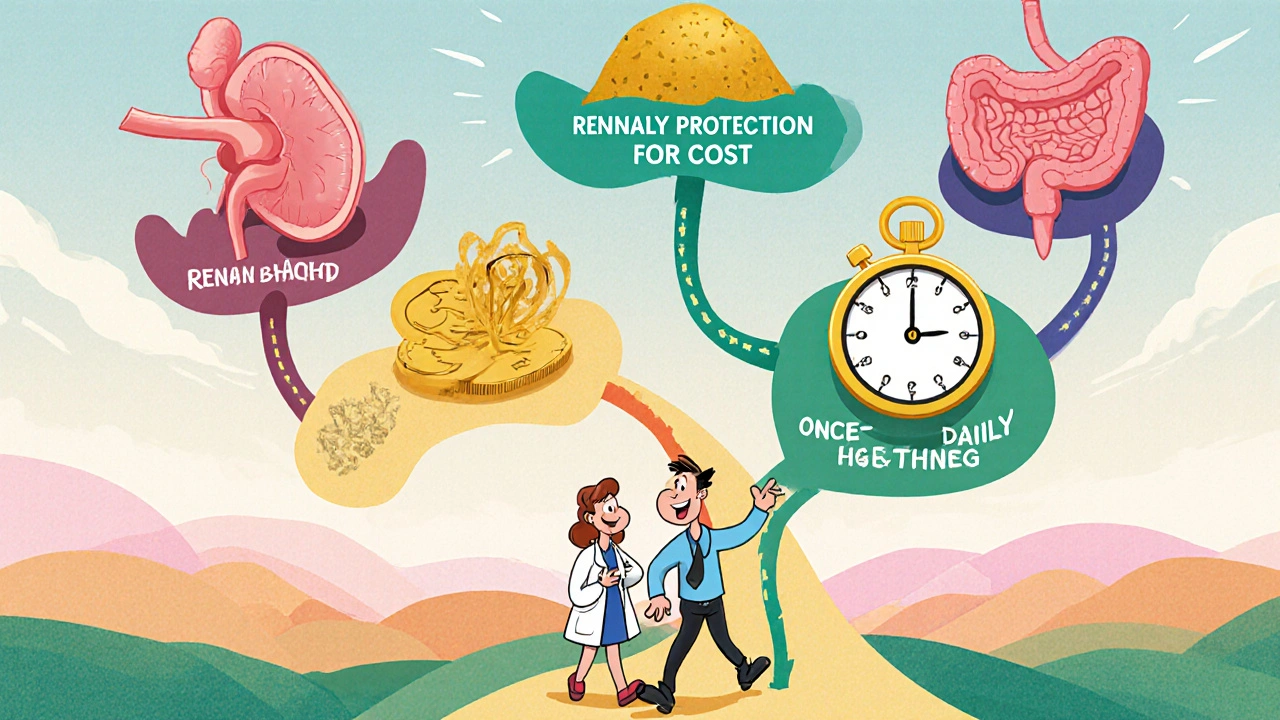ARB Selection Guide
This tool helps you identify the most appropriate ARB (angiotensin receptor blocker) for your specific needs based on the information in the article. Answer the following questions to get a personalized recommendation.
Quick Takeaways
- Candesartan is an ARB approved for hypertension and heart‑failure management.
- It offers a once‑daily dosing schedule and a long half‑life (≈9hours) that smooths blood‑pressure control.
- Losartan, Valsartan, Irbesartan, Telmisartan and Olmesartan share the same class but differ in cost, renal benefits and drug‑interaction profiles.
- When choosing an alternative, weigh factors such as price, kidney protection, metabolic effects, and patient tolerance.
- Switching drugs safely requires a clear taper‑or‑cross‑over plan and a follow‑up BP check within 2weeks.
What Is Candesartan?
When treating high blood pressure, Candesartan is an angiotensinII receptor blocker (ARB) that relaxes blood vessels, reducing the effort the heart must pump against. The brand name Atacand was launched in 1998 and quickly became a go‑to option for both hypertension and chronic heart failure.
How Candesartan Works
The renin‑angiotensin‑aldosterone system (RAAS) produces angiotensinII, a peptide that tightens arteries. Candesartan blocks the AT1 receptor where angiotensinII binds, preventing the vasoconstriction signal. The result is a steadier, lower systolic and diastolic pressure without the cough often seen with ACE inhibitors.
When Doctors Prescribe Candesartan
Candesartan is FDA‑approved for:
- Essential hypertension (usually 8‑32mg once daily).
- Heart failure with reduced ejection fraction (4‑32mg once daily, often added to a beta‑blocker).
- Kidney protection in patients with diabetic nephropathy - studies show a ~20% slower decline in eGFR compared with placebo.
Typical side‑effects are mild: dizziness, hyper‑kalemia, or occasional headache. Because it isn’t metabolised by the liver’s CYP2C9 pathway, drug‑drug interactions are fewer than with some other ARBs.

Alternative ARBs on the Market
All ARBs share the same basic mechanism, yet each has quirks that matter in real life. Below are the most common alternatives.
Losartan is the oldest ARB, approved in 1995. It’s inexpensive and has a well‑documented safety record.
Valsartan gained attention after a 2018 recall of a contaminated batch, but the drug itself offers strong blood‑pressure control at mid‑range prices.
Irbesartan is often chosen for patients with type‑2 diabetes because it shows a modest reduction in albuminuria.
Telmisartan has the longest half‑life (≈24hours) and a slight PPAR‑γ agonist effect, which can improve insulin sensitivity.
Olmesartan is praised for its potent BP‑lowering at low doses but carries a rare risk of sprue‑like enteropathy.
Side‑by‑Side Comparison
| Drug | Typical Daily Dose | Half‑Life | Cost (US avg.) | Renal Benefit* | Unique Note |
|---|---|---|---|---|---|
| Candesartan | 8‑32mg | ≈9h | $0.30‑$0.45 per tablet | Yes - slows eGFR decline | Low CYP interaction risk |
| Losartan | 25‑100mg | ≈2h (active metabolite 6‑9h) | $0.10‑$0.20 per tablet | Modest | Cheapest generic ARB |
| Valsartan | 80‑320mg | ≈6h | $0.25‑$0.35 per tablet | Limited data | Recall history (2018) |
| Irbesartan | 150‑300mg | ≈11h | $0.30‑$0.40 per tablet | Strong - especially in diabetics | Often paired with diuretics |
| Telmisartan | 40‑80mg | ≈24h | $0.40‑$0.55 per tablet | Good - PPAR‑γ effect | Once‑daily dosing works well for adherence |
| Olmesartan | 20‑40mg | ≈13h | $0.35‑$0.50 per tablet | Effective | Rare enteropathy risk |
Pros and Cons of Each Option
Candesartan
- Pros: Strong renal protection, low interaction profile, once‑daily dosing.
- Cons: Slightly higher price than Losartan, limited formulary coverage in some plans.
Losartan
- Pros: Cheapest generic, widely available, good safety record.
- Cons: Shorter half‑life may need twice‑daily dosing for tighter control.
Valsartan
- Pros: Effective BP reduction, moderate cost.
- Cons: Recall history may make prescribers hesitant; not the best for kidney disease.
Irbesartan
- Pros: Best evidence for diabetic nephropathy.
- Cons: Higher pill burden if combined with a diuretic.
Telmisartan
- Pros: Long half‑life → true once‑daily; metabolic benefits.
- Cons: Premium price; may cause mild dizziness in elderly.
Olmesartan
- Pros: Potent lowering effect; convenient dosing.
- Cons: Very rare sprue‑like enteropathy; monitor GI symptoms.

How to Choose the Right ARB
Here’s a quick decision tree you can run through with your doctor:
- Is kidney protection a top priority?
If yes → Candesartan or Irbesartan. - Is cost the biggest concern?
If yes → Losartan. - Do you need a drug that can be taken once daily without missing doses?
If yes → Telmisartan or Candesartan. - Any history of gastrointestinal issues?
If yes → Avoid Olmesartan. - Are you on multiple meds that use the CYP450 system?
If yes → Candesartan (low CYP interaction).
After picking an alternative, schedule a follow‑up BP check in 7‑14days. This short window catches any rebound hypertension early.
Step‑by‑Step Guide to Switching ARBs
- Tell your prescriber which drug you want to switch from and why (cost, side‑effects, renal goals).
- Doctor writes a new prescription, usually at the same dose strength if the half‑life is similar.
- Stop the old pill on the day you start the new one (no overlap needed for most ARBs).
- Check your blood pressure twice daily for the first week.
- Report any dizziness, swelling, or sudden rise in BP to your clinic.
Frequently Asked Questions
Can I take Candesartan with an ACE inhibitor?
Combining two drugs that block the RAAS (like an ARB and an ACE inhibitor) increases the risk of high potassium and kidney injury. Doctors only do it in very specific heart‑failure protocols and monitor labs closely.
Is Candesartan safe during pregnancy?
No. ARBs are classified as pregnancy‑category D. They can cause fetal kidney defects. Switch to methyldopa or labetalol if you become pregnant.
How quickly does blood pressure drop after starting Candesartan?
Most patients see a 5‑10mmHg reduction in systolic pressure within 2weeks. Full effect may take up to 4weeks as the drug reaches steady state.
What should I watch for when switching to Losartan?
Because Losartan’s active metabolite builds up slower, you might feel a mild rise in BP the first few days. If it stays high after a week, contact your provider.
Are there any food interactions with Candesartan?
None that are clinically significant. However, a very high‑potassium diet (e.g., bananas, potatoes) can push potassium levels up when you’re already on an ARB.
Next Steps for Patients and Providers
If you’re already on Candesartan and are happy with your BP numbers, keep the dose and schedule annual kidney‑function labs. If cost or side‑effects are a concern, bring the comparison table to your next visit and discuss a switch. For clinicians, consider electronic‑health‑record alerts that flag patients with eGFR <60ml/min/1.73m² - these folks benefit most from Candesartan’s renal protection.



william smith
For anyone weighing ARBs, Candesartan gives solid kidney protection and a convenient once‑daily dose, making it a strong first‑line pick when price isn’t the primary barrier.
October 15, 2025 AT 12:07
Timothy Javins
Honestly, the extra renal benefit isn’t worth the higher price tag; most patients do fine on cheap Losartan and save a lot.
October 16, 2025 AT 18:40
Kay Yang
Interesting point, but many folks value the lower interaction risk of Candesartan, especially when they’re on multiple meds 😊. It’s also nice to have the consistent BP control without twice‑daily dosing.
October 18, 2025 AT 01:13
Rajesh Kumar Batham
Totally agree! 🌟 The once‑daily schedule really helps adherence, and the reduced CYP interaction is a win for polypharmacy patients. 👍
October 19, 2025 AT 07:47
Bill Gallagher
Candesartan stands out in the ARB class because, unlike Losartan’s relatively short half‑life, it maintains plasma concentrations that smooth out blood‑pressure fluctuations throughout the day; additionally, its minimal metabolism via CYP2C9 reduces the risk of drug‑drug interactions, which is particularly important for patients on complex regimens, such as those with diabetes or heart failure; moreover, the renal protective data, showing a roughly 20% slower eGFR decline, provide a compelling argument for its use in diabetic nephropathy, though one must consider the modest price premium; on the other hand, drugs like Telmisartan boast a 24‑hour half‑life and a PPAR‑γ agonist effect, which may benefit insulin sensitivity, but they come at a higher cost and occasionally cause dizziness in the elderly; Valsartan, while effective, suffered a recall that still haunts prescribers, despite its decent safety profile; Irbesartan is often paired with diuretics for synergistic effect, yet the pill burden can be an issue; Olmesartan’s potent BP lowering is attractive, but the rare sprue‑like enteropathy warrants caution; therefore, when choosing an ARB, clinicians must balance efficacy, safety, cost, and patient preference, perhaps opting for Candesartan when kidney protection and low interaction risk are paramount, while reserving Losartan for those prioritizing cost, and Telmisartan for adherence‑focused patients.
October 20, 2025 AT 14:20
Rajashree Varma
Candesartan can be a great choice for patients who need kidney protection and want a simple once‑daily pill it works well and is easy on the body
October 21, 2025 AT 20:53
Anshuman Pandey
Choosing a medication is like picking a path in life it reflects our values and priorities the balance of cost and benefit mirrors the balance we seek in everyday decisions
October 23, 2025 AT 03:27
Thomas Malloy
Cost matters.
October 24, 2025 AT 10:00
Sushma Gowda
Everyone’s situation is unique, so consider the full picture-blood pressure control, kidney health, cost, and how easy it is to remember the dose.
October 25, 2025 AT 16:33
Angie Wallace
It might be worth looking at the table for a quick comparison.
October 26, 2025 AT 22:07
Doris Montgomery
Honestly the article is a bit too detailed for most readers.
October 28, 2025 AT 04:40
Nick Gulliver
American doctors know better than to waste money on overpriced meds when a cheap generic does the job.
October 29, 2025 AT 11:13
Sadie Viner
In conclusion, while Candesartan offers noteworthy renal benefits and a favorable interaction profile, the decision must be anchored in a comprehensive assessment of patient‑specific factors, cost considerations, and therapeutic goals, thereby ensuring optimal clinical outcomes.
October 30, 2025 AT 17:47
Kristen Moss
Yo, ditch the fancy stuff and just stick with the cheap stuff, no need to overcomplicate.
November 1, 2025 AT 00:20
Rachael Tanner
While Candesartan sparkles with renal protection, Losartan humbly mans the cost frontier, and Telmisartan struts with a marathon half‑life-pick your poison, dear reader.
November 2, 2025 AT 06:53